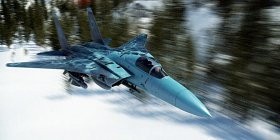|
• Source: 3Dup.com - The Computer Graphics Portal • URL: http://3dup.com/news/view.vfx?nid=279 • Category: Miscellaneous
Ever wonder what it feels like to be behind the gearstick of a fighter jet?
3Dup.com - November 14, 2009 - 00:14
 RealtimeUK, established in 1996, is a CG Production house based in Lancashire, directed by important producers and directors from the games and television industry. They work with leading companies, producing CG animations for video games, television commercials and digital campaigns.
RealtimeUK, established in 1996, is a CG Production house based in Lancashire, directed by important producers and directors from the games and television industry. They work with leading companies, producing CG animations for video games, television commercials and digital campaigns.To date, RealtimeUK’s client base boasts such well known names as Sony Computer Entertainment Europe, Disney Interactive Studios, THQ, Evolution Studios, Eidos, Codemasters, Sega and Namco. Some of their most remarkable projects have included this Stormbirds for THQ and Split/Second for Disney Interactive Studios, Marketing and Intro trailers for Motorstorm 1 & 2 as well as all the Buzz! intro movies for Sony Computer Entertainment Europe and Juiced 2: Hot Import Nights for Juice Games. INTERVIEW WITH PRODUCER, STEVEN KERSWELL Can we have more details about your production Stormbirds? Stormbirds was one of the most enjoyable of our productions. I think the great thing with this one was it engaged on so many levels, the pre-vis was inspiring, the modellers were in their element, the environment guys loved the backgrounds, the animators got to create some cool moves and there’s even a nuclear explosion thrown in for good measure! What more could we ask for?  We probably had our strongest pre-vis so far on this one, the client had some really nice game design concepts and we just picked the best frames and developed them further. What tools did you use to create the natural scenery and vegetation we see throughout the piece? The rainforest was created with a mixture of VUE, camera mapping and matte’s. The other environments such as the snowy mountains and the canyons were all modelled in 3dsmax and either texture mapped traditionally or camera mapped. What software and techniques did you use to create the planes? Most things that weren’t part of the landscape, such as the planes, were modelled in 3dsmax, UV’s were generated in UVLayout and texturing created in Photoshop. The client provided low-poly game planes which we used as templates for the initial model block-outs and also featured in the animatic. There were similarities with existing fighter jets, so our research started with a visit to an aviation museum and then moved on to creating moodboards for further inspiration. What was the most creative part of the modelling, animation, rendering process? Can you provide some details? The most creative part of this animation was taking a game design document and making it into a cinematic movie experience. When you are playing a game you often see things from one view, the drivers’ seat, but we needed to engage the viewer in as much of the action as possible, switching from being the pilot to a spectacular view of the aftermath you’ve just created. How have you managed the heat effects and explosions? We used Particle Flow and Afterburn for the explosions. We spent a lot of time carefully studying explosion footage and fine tweaking our particle systems so that the volumes of smoke would expand, roll and grow in the correct way. Strong ambient omni lights and Afterburn’s explode daemons were used to create the firey core to these explosions. The heat effects were also created as an Afterburn system and then composted into the footage as a distortion effect. What part of the modelling, animation, rendering process posed the greatest technical challenge? How did you proceed? The biggest challenge was the size and diversity of the environments. Our extensive pre-vis was a massive help, but nailing the camera work & animation as early as possible allowed maximum use of camera mapping and matte back plates. Rendering canyon runs could have been problematic with the vast distances covered in a short time, however using VRay proxy objects for the trees allowed for a manageable & stable scene. More Information at www.realtimeuk.com. Image and Video Courtesy of RealtimeUK. Video Transcoding: 3Dup.com |